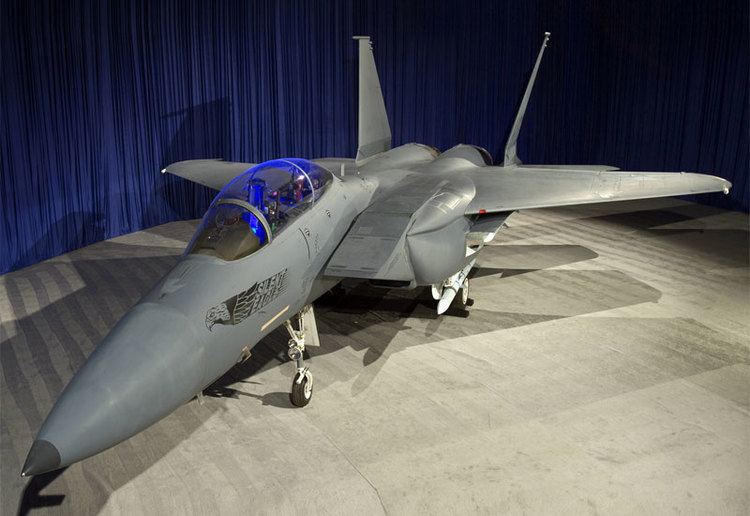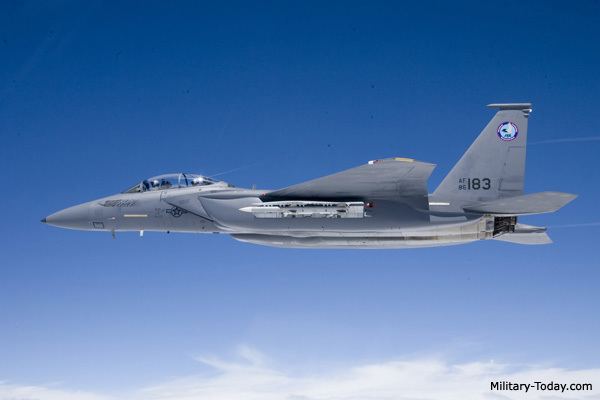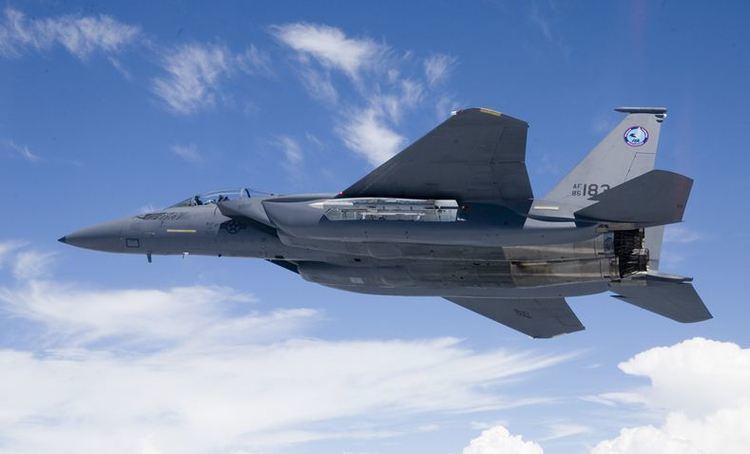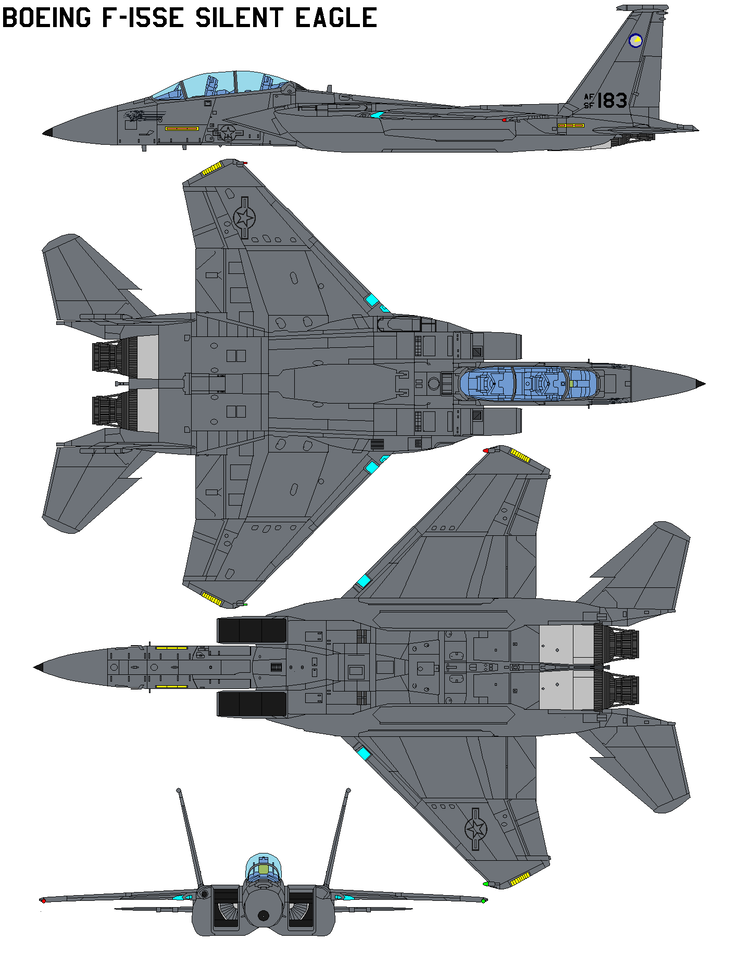Top speed 2,680 km/h Weight 14,380 kg Wingspan 13 m | Range 3,862 km Cruise speed 917 km/h Engine type Pratt & Whitney F100 | |
 | ||
Unit cost 100,000,000–100,000,000 USD (2009) | ||
Boeing f 15se silent eagle
The Boeing F-15SE Silent Eagle is a proposed upgrade of the F-15E strike fighter by Boeing using stealth features, such as internal weapons carriage and radar-absorbent material.
Contents
- Boeing f 15se silent eagle
- Boeing f 15se silent eagle missile launch
- Design and development
- Seeking partners and sales
- Specifications
- References

Boeing f 15se silent eagle missile launch
Design and development

On 17 March 2009, Boeing first displayed a F-15SE demonstrator. The F-15SE will use fifth generation fighter technologies, such as radar absorbing materials, to reduce its radar cross-section (RCS). Distinguishing features are the conformal weapons bays (CWB) that replace the conformal fuel tanks (CFT) to hold weapons internally (reducing fuel capacity) and the twin vertical tails canted outward 15 degrees to reduce radar cross section. Different levels of RCS reduction were studied.

The F-15SE shall have a level of stealth that the U.S. government allows for export, being optimized for air-to-air missions (against X-band radars) and much less effective against ground radars (which use other frequencies). Boeing stated that this stealth will only be in the range of fifth generation aircraft such as the F-35 Lightning II from the frontal aspect. The F-15SE will have a Raytheon AESA radar, and a new BAE Systems electronic warfare system. Weapons can be carried both internally and externally on hardpoints under each wing. New build F-15SEs will be lighter and more fuel efficient than Strike Eagle conversions due to the canted tails, fly-by-wire controls, and digital EW equipment; enabling two additional weapons stations on the wings.
In March 2009, Boeing formally launched the F-15SE for international sales; it was aimed at F-15 users such as Israel, Saudi Arabia, Japan, and South Korea. Boeing estimated the unit cost as approximately US$100 million, including spares and support; its lower cost compared to fifth generation fighters was intended to appeal to the export market. In 2009, Boeing began tentative talks with South Korea over the Silent Eagle, but was unable to market it to international customers without an export license from the US government. Boeing filed for an export license in early 2010, and received it in July 2010. In August 2010, clearance was granted to export the F-15SE's radar cross-section treatments and electronic warfare suite to South Korea.

During August and September 2009, Boeing performed RCS testing on an F-15E with different radar absorbent coatings to select a coating. The first production F-15E (86-0183) was modified to the F-15E1 configuration to serve as a demonstrator. It first flew on 8 July 2010 with a left-side CWB, and on 20 July 2010 launched an AMRAAM from a CWB.
Seeking partners and sales

Boeing sought other companies to be risk-sharing partners to reduce development costs. In November 2010, Boeing signed an agreement with Korea Aerospace Industries for KAI to design and manufacture the F-15SE's CWB. KAI had previously produced wings and forward fuselages for F-15K and F-15SG. On January 2012, the Korea Times reported that only 10% of the design work on the CWB had been completed, and that development of the canted vertical tails had been suspended in 2010. However, Boeing had stated that development continued with scale model wind tunnel tests scheduled for spring 2012.
In July 2010, diplomatic sources reported that U.S. President Barack Obama had refused Israeli Prime Minister Benjamin Netanyahu's request for access to the "stealth F-15E". Israel held several discussions over the F-15SE as an alternative to the F-35 Lightning II. In August 2010, Israel opted to buy the F-35. In 2015, Israel requested a squadron of Silent Eagles.
In September 2009, Saudi Arabia was reportedly considering purchasing up to 72 F-15s. Although the F-15SE received initial interest, the less advanced F-15SA was ordered in 2012, four of these Jets were pictured at an RAF base during December 2016 in transit to Saudi Arabia, it was reported that the jets were part of an order of 84
The F-15SE was submitted for Japan's F-X project, but Japan instead decided to purchase the F-35 in 2011.
In South Korea's F-X III fighter program, the F-15SE was bid against the F-35 and Eurofighter Typhoon. Existing F-15s were used for a flyoff against the Typhoon, and an F-35 flight simulator. On 18 August 2013, the South Korean Defense Acquisition Program Administration (DAPA) announced that the F-15SE as the only remaining candidate; the F-35 being too costly and the Typhoon disqualified for bidding flaws.On 24 September 2013, the defense ministry rejected the award, saying that a new competition would be held. On 22 November 2013, it was reported that South Korea will purchase the F-35A. Boeing had shifted from the F-15SE to the "Advanced F-15".
Specifications
Basic specifications listed are for the F-15E Strike Eagle, on which the F-15SE is based.
Data from USAF F-15E fact sheet, Davies, and Boeing Silent Eagle
General characteristics
Performance
Armament
Avionics
